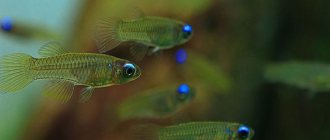Home » Other animals
If experienced aquarists can choose any fish, even the most exotic and capricious in keeping, then beginners, as a rule, are afraid to get specimens about which they know little. To figure out what kind of animal this is - a cockroach - and how to keep it, you need to study this species in detail. Perhaps you should start learning the basics of aquarium keeping with this fish.
- 2 Description of appearance
2.1 Sex differences
- 5.1 Character trait
5.1.1 Video: playful cockroach and his neighbors
- 6.1 Video: spawning of cockroaches
- 7.1 Video: behavior of a catfish infected with ichthyophthyriasis
A Brief History of Tarakatum
The common tarakatum is a heat-loving catfish. In Latin it sounds like Hoplosternum thoracatum, but modern aquarists often write the name of the catfish as they hear it, tarakatum.
In 1997, Hoplosternum was studied by Roberto Reis. He separately described several species of this genus. He named the Tarakatums, which are now kept by aquarists, Megalechis thoracata. Thus, several popular names were assigned to the catfish: tarakatum, spotted catfish, hoplo, bubble nest, etc. The name of this fish is translated as shell - the front part of the catfish’s body is covered with durable bone plates.
The homeland of cockroaches is South America - the Amazon, Orinoco, and Paraguay rivers. In addition, catfish inhabit some rivers in Florida, where they were introduced by accident.
Tarakatums live in large schools and lead a bottom-dwelling lifestyle. Their lifespan in the wild is about 12-13 years, and in an aquarium, subject to proper maintenance, it can reach 20 years.
Maintenance and care
To keep cockroaches, you will need to have a spacious aquarium of 150 liters or more. You will need another one if you plan to breed catfish - it can be smaller by about 100 liters. It is worth filling the containers 1/3 with boiled water and 2/3 with settled water; every week you need to change one third of the total volume.
Since in natural conditions cockroaches live in warm bodies of water, they need to organize similar conditions:
- the temperature is maintained from 24 to 27 degrees;
- acidity from 5.7 to 7.6;
- hardness from 20 to 25;
- many living plants to diffuse incoming light;
- grottoes and other shelters so that catfish can hide;
- large and smooth substrate instead of soil;
- systems for round-the-clock filtration and aeration;
- An air compressor is required;
- Choose lighting so that it is not very bright.
When choosing plants, pay attention to those species that will create maximum darkness, but not completely block access to the surface of the water. They should have wide leaf blades. It’s good to have swimming species:
- riccia;
- duckweed;
- hornwort;
- nayas.
If you choose the wrong soil, the water will be cloudy. Large gravel and pebbles are suitable for catfish.
The aquarium filter must be powerful enough to move the water, creating a flow effect. It is best to install the aquarium away from a source of daylight; catfish do not like bright lighting. If you plan to put lamps in it, they should not be very bright.
Description of appearance
The catfish is light brown in color. All over its body, including its fins and tail, there are dark spots that appear in adolescence and remain for life. As they mature, the overall color becomes darker. The belly of the fish is light, whitish, but in males during spawning it acquires a bluish tint. Tarakatum boasts two pairs of luxurious mustaches - one of them sticks out in different directions and is directed upward, the second - downward and forward.
A distinctive feature of the species is the location and direction of the whiskers, as well as a bright orange spine on the pectoral fin
Sex differences
You can distinguish a female from a male with the naked eye thanks to the pectoral fins: in females they are rounded, smooth, in males they are larger and triangular in shape, while the first ray of the fin resembles a needle and turns orange during spawning.
The male cockroach (right), unlike the female (left), has more powerful fins equipped with spines to protect its territory from strangers
More experienced aquarists can distinguish between females and males by the plates covering the chest of the fish. In males, the plates are covered with spots and arranged in the shape of the letter “V”, while in females this shape is more blurred, not so clear.
How to distinguish a male from a female?
A male can be distinguished from a female by two characteristics:
- Initially you need to pay attention to the fins. In the male they are pointed and elongated. The pectoral fin is covered with red bony spines, which turn orange during spawning. Also during this period, the color of his belly becomes blue, but the rest of the time it is creamy white.
- The female is larger than the male. Its fins are short and round in shape.
The main difference between males and females is their fins
Under natural conditions, the cockroach grows up to 20 cm, but in captivity its body length reaches only 13-16 cm. Life expectancy in an aquarium varies from 5 to 10 years. Tarakatum has intestinal respiration. It lives in the lower layers of the aquarium, becomes active at night, and during the day tries to hide from light.
Females are generally larger than males
Important! Tarakatum can swallow air on the surface of the water, which allows it to live in polluted water bodies.
Parameters of a comfortable living environment
This species of catfish is an unpretentious fish. In the wild, they can live in both soft and hard water, which should be fresh, but spotted catfish also survive in brackish water. The aquarium should be spacious (100-150 liters). The water temperature that is comfortable for catfish is 24-28 °C, and the pH is about 6-8.
Since catfish can grow large (up to 15 centimeters), there should be no more than 6 individuals of this species, and only one male. Male individuals will fight for leadership and the dominant one may cripple the weaker (especially during the spawning period).
A spacious aquarium is not only a home decoration, but also one of the prerequisites for keeping catfish
The armored fish is adapted to river conditions, so using an aerator you can organize a slight movement of water. A bottom lifestyle does not mean a comfortable stay in dirty water - you should install a filter. In addition, you need to change the aquarium water - 25% of the total water volume per week. Catfish eat a lot, which will create a lot of organic waste. The bottom can be periodically cleaned using a syringe. Catfish are unpretentious to light, so you can organize lighting in accordance with the rules for keeping other fish.
Tarakatums also have some peculiarities. The fish's intestines are equipped with an additional respiratory organ, so it is able to absorb oxygen air by floating to the surface of the water. Due to the weight of the body, the catfish has to accelerate. Sometimes he miscalculates his own strength, jumps out of the aquarium and dies. To protect the fish, the aquarium must be installed with a lid. If there was no lid included with the aquarium, you can simply cover the container, leaving a small hole for air flow.
The aquarium should have coarse soil - gravel, artificial stones, driftwood, grottoes and algae. The need for a large substrate is due to the fact that catfish like to swarm at the bottom and “muddy” the water, and grottoes are needed as shelter and for overgrowing with small algae. If there are no shelters, you need to make sure that the algae is broad-leaved - this way the fish can hide in the shade of the leaves. Typically, catfish hide during the day and are awake at night.
What does a cockroach eat?
Catfish is unpretentious to food. In the wild, it feeds on insects, their eggs and various humus. In an aquarium, cockroaches will happily eat animal food (both fresh and frozen), most pellets and sunken flakes.
Specifications
- Minimum aquarium size: about 100 liters
- Content difficulty: easy
- Personality: peaceful
- Water temperature: 20-28 degrees Celsius
- Water pH: 5.5 - 8.3
- Color: gray, brown
- Diet: omnivore
- Compatibility: fits well in community aquariums
- Origin: Amazon Basin
- Life expectancy: 5 – 8 or more years
- Suitable for beginner aquarists
Feeding rules
Tarakatums eat live and dry food. Catfish have a voracious appetite, although they seem indifferent to what is happening. Catfish need a variety of foods. These fish are real gluttons. Live foods (bloodworms, earthworms and even meat, such as shrimp) can be used as protein food, but some individuals prefer vegetarian cuisine, so taste preferences must be taken into account individually. Some dry food manufacturers combine plant and animal ingredients in their products.
It is better to buy dry food in packaged packages (not by weight). Opened packaging must be stored in a tightly closed container, otherwise pathogenic flora may begin to multiply in it, which will adversely affect the health of the fish.
Tarakatums are unpretentious to food, but an incorrect diet can lead to the development of diseases
Colonies of algae, which grow over driftwood and the surfaces of decorative elements, are suitable for feeding catfish. This treat promotes proper digestion and brightness of color. It is better to feed the catfish slowly. Having given the bulk of the food to the inhabitants of the aquarium, you need to make sure that everyone eats. And then add more food - especially for the catfish. Even if he doesn't eat his supplement right away, the food will fall to the bottom, and at night he will pick it up. If you watch a catfish at night, you can see how it becomes more active and swims along the bottom in search of food, feeling the ground with its mustache.
Compatibility with other fish
Tarakatums are peaceful and easy-going fish. But there are two basic rules for selecting neighbors. Firstly, the fish must be proportionate to the catfish, because even a peaceful catfish, if it is very hungry, can eat a small fish. This does not indicate aggression, and such behavior is the exception. And secondly, you cannot house catfish and predatory fish together. For example, cichlids become undesirable neighbors. A large predatory fish will bully a sleepy cockroach. The conflict can turn into a real battle, the consequences of which will be injuries on both sides. Smaller but aggressive fish (for example, labeo) can also bully catfish: a struggle for territorial leadership may begin between the males of the two species.
The catfish will not cause any trouble for calm and large fish - it is friendly and patient, and during the day it almost always hides, allowing others to move freely
Females of the same species become ideal neighbors for cockroaches - their personalities and daily routine will coincide, and there will be no reasons for conflicts. In addition, it is easier to keep fish of the same species.
Character trait
Quite often in jokes and ironic statements we hear the phrase “memory like a fish.” This means that the fish is not able to remember. Even if the owner changes every day, she will not notice it. But a catfish is an exception to the rule, especially if it has lived with one owner all its life.
In the evening he swims up to the glass and looks. He begins to fidget, move his mustache, as if he is sniffing through glass. It can suddenly float up, take a breath of air, return to its place, and looking at me, exhale this bubble.
Video: playful cockroach and his neighbors
Torakatum
Torakatum
Tarakatum is one of the most common catfish in our aquariums. Their popularity is due to the unpretentiousness of keeping, endurance and peaceful disposition of these fish.
Latin name: Hoplosternum thoracatum.
Correct name: Many call this fish tArakatum, probably comparing it with a cockroach, but it is still correct to say thorakatum, from the Latin “thorax” - shell.
Synonyms: Torakatum, hoplosternum, catfish thoractum, tarakatum catfish. Order, family: Armored catfish. Water temperature: 22-28° C. Ph “acidity”: 5.8-7.5. dH: up to 25°. Aggressiveness: 0% non-aggressive. Content difficulty: Very easy. Compatibility: In fact, any fish - these catfishes - do not pose any threat to other inhabitants of the aquarium.
Incompatible: Tarakatums do not get along with aggressive and predatory fish, such as large cichlids. It is not recommended to keep them with labeos and bots, as the latter chase them, which is explained by the struggle for territory. In addition, it is better not to combine cockroaches with fish that are too small; at some point, the catfish may still eat the small fry.
How long do they live: cockroaches are long-lived in aquariums and can live more than 10 years. You can find out how long other fish live
Reproduction and breeding
Some aquarists specifically keep these catfish because of the unusual spawning process. When the female and male are ready to spawn, and conditions allow it, the male begins to build a nest. In nature, the catfish collects pieces of algae and other materials and builds a nest up to 3 centimeters in height from all this. To do this, he uses a wide sheet on the surface of the water. For nesting, the cockroach will swim with its belly up and pump up foam. Foam is formed from bubbles that the catfish spits out. The bubbles do not burst because they are lubricated with special mucus.
A female with a rounded belly will try to nestle into a cozy place, but the male will kick her out. When the nest is ready, he will invite her himself. After this, the female catfish folds her pelvic fins into her “palms,” lays several eggs and carries them to the foam nest. The male inseminates the eggs with milk and pumps more foam so that they do not move away from the nest. This process is repeated until all the eggs are in the nest (up to 1000 eggs). Then the tired female needs to be transplanted, and another one, if available, should be allowed in with the male. When the nest is filled and replaced properly, the male begins to guard it. It will drive away any moving object - a net, other fish, a person’s hand, etc.
Video: spawning of cockroaches
Until the eggs are “ripe,” the catfish will not eat, so you don’t have to worry about feeding it. He will be busy with the nest all the time: correcting, foaming, returning fallen eggs. If the egg sinks to the bottom, then nothing bad will happen - it will hatch at the bottom. At optimal water temperature (27-28 °C), the eggs will hatch in about 4-5 days. As soon as the first batch of fry appears, the male is placed in a separate aquarium and fed - after a few days of diet, the catfish becomes pretty hungry and can eat eggs. For the first couple of days (sometimes a day), the fry may “fuss” around the nest, but then they will gradually sink to the bottom. After a couple of days, the fry can be fed, for example, with brine shrimp (a type of crustacean) or crushed food for adult catfish. The fry will not die of hunger - when descending to the bottom, it will find its first food there.
The young grow very quickly. In two months, the fry can grow up to 4 centimeters - at this size, you can start feeding them food for adults, increase filtration and change the water more often. Babies will grow at different rates, so you need to install several aquariums and sort them by size.
Video: catfish fry sank to the bottom
How do they reproduce?
By the age of 8 to 15 months, catfish are ready to spawn. They form pairs on their own, so all you have to do is prepare a separate aquarium for them with ideal conditions for breeding. In general water, you can also provoke the reproduction of fish, but this is only possible if all the inhabitants of the aquarium are able to withstand temperatures from 20 to 24 degrees.
At this time, it is necessary to increase the proportion of animal products in the fish diet. In this case, there should be so much food that the catfish literally bump into it while moving. It is imperative to use floating plants in the spawning aquarium, under which the male will prepare a nest. You can help him with this by placing an inverted saucer on the bottom.
Mating games can last a very long time, up to 10 days. Be patient, at this time the male chooses the best place for the nest and makes sure it is safe. The spawning process goes like this: the female takes milk into her mouth, and then rises to the leaves of the plant and begins to spawn eggs, trying to stick them.
After about 10 days, the eggs will hatch into fry, which, falling to the bottom of the aquarium, immediately begin to look for food. This is where a saucer comes in handy; you need to scatter live dust, finely chopped tubifex, brine shrimp or daphnia over it. Babies can be moved into a community aquarium when the babies begin to swim independently.
How to distinguish a male from a female
To know approximately how many pairs your cockroaches can form, you need to be able to distinguish males from females:
- females are larger than males;
- the fins of females are rounded, those of males are triangular;
- in males, during sexual activity, the ray of the pectoral fin becomes yellow-orange, in normal times it stands out for its thickness - this sign becomes noticeable in six-month-old individuals;
- the female becomes a little fuller at maturity;
- The male's abdomen changes color from light to violet-blue.
During puberty, the differences between catfish of different sexes become more obvious, and until this time it is worth focusing on the fins.
Tarakatum diseases and treatment methods
Most often, aquarists are concerned about the external sores of catfish (loss of scales, molting, the appearance of purulent blisters, etc.). In such cases, the sick fish must be urgently placed in a separate container, its relatives examined, the aquarium cleaned and the water analyzed.
Tests for the presence of harmful substances in aquarium water can be purchased at a pet store, but it is better to stock up on them in advance so that they are always on hand.
A catfish that has fallen ill must be shown to a specialist; most likely, it will need antibiotics and other medications.
Catfish almost always lead a bottom-dwelling, nocturnal lifestyle. Consequently, they are most at risk due to water contamination, and identifying a problem in their health is quite difficult - which is why it is so important to monitor the purity of the water and the conditions of their detention.
Under no circumstances should threads or other strong fibers be allowed to get into the water. Catfish love to pick at plants, and if they find a thread there, they will definitely get entangled. It will be difficult to notice this, and a tethered catfish will not be able to emerge for air. So he can die from hypoxia.
If you can diagnose the disease yourself, you can try treatment. One of the most contagious diseases in catfish is ichthyophthyriasis (“semolina”).
Sometimes it happens that a catfish lies on its side for no apparent reason or swims in the same position. If, with the help of tests, all deficiencies in water quality are excluded, then two problems remain: ichthyophthyriasis or overfeeding.
A sick fish should be removed immediately. The medicine usually prescribed is Malachite green or Aquamed. But with any drug treatment, it is important to understand that the appearance of white dots is a symptom of the disease.
If you are afraid to use Malachite Green in the fight against semolina, you can try Sera Costapur. Before use, increase the power of all devices, including the filter and aerator, and replace 20% of the water. The drug is poured overnight; sick fish are not fed. If there are adsorbents in aquarium devices (for example, carbon in a filter), they need to be removed. Wash all porous device sponges thoroughly daily. It must be remembered that catfish have difficulty accepting any medications, so the drug should be given in 1/2 fractions of what is indicated in the instructions.
Another common problem in fish is fungus. Light spots first appear on the body of the fish, and then they become overgrown with “cotton wool”. Only fish with weakened immune systems get sick with fungal diseases. The fungus develops in open wounds, so sharp stones should not be placed in the aquarium. Sick individuals lie weakened, do not eat and breathe heavily. Red spots appear around the “cotton wool”. The sick fish should be placed in a quarantine tank, and a weak solution of potassium permanganate should be added to the water. The procedure can be repeated again.
Video: behavior of a catfish with ichthyophthyriasis
What to do if your mustache falls off
There are often situations when a catfish looks healthy, but its whiskers have fallen off. This can happen symmetrically (a pair) or asymmetrically (one whisker). Tarakatums love to burrow in the ground, and if the substrate is not suitable in properties and characteristics, then the fish may get injured. Bacteria can get into a small wound on the catfish's face - this is what contributes to the loss of whiskers. In such cases, the sick individual must be removed and enhanced aeration and filtration provided. Separately, you can make a bath with trypaflavin-ultra (for example, in a bowl).











